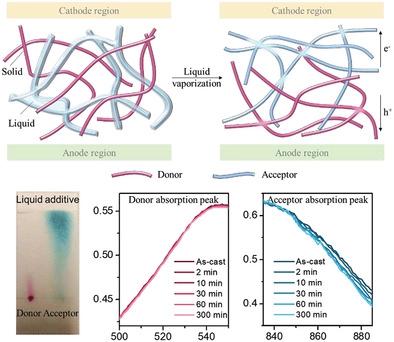当前位置:
X-MOL 学术
›
Adv. Energy Mater.
›
论文详情
Our official English website, www.x-mol.net, welcomes your
feedback! (Note: you will need to create a separate account there.)
Modulating the Mixing Gibbs Free Energy to Enhance Solid–Liquid Phase Separation for High-Performance Organic Solar Cells
Advanced Energy Materials ( IF 24.4 ) Pub Date : 2023-02-13 , DOI: 10.1002/aenm.202203697
Xinjun He 1 , Christopher C. S. Chan 2 , Xinhui Zou 2 , Sen Zhang 3 , Patrick Wai Keung Fong 4 , Jinwook Kim 1 , Gang Li 4 , Xiaotian Hu 5 , Wei Ma 3 , Kam Sing Wong 2 , Wallace C. H. Choy 1
Advanced Energy Materials ( IF 24.4 ) Pub Date : 2023-02-13 , DOI: 10.1002/aenm.202203697
Xinjun He 1 , Christopher C. S. Chan 2 , Xinhui Zou 2 , Sen Zhang 3 , Patrick Wai Keung Fong 4 , Jinwook Kim 1 , Gang Li 4 , Xiaotian Hu 5 , Wei Ma 3 , Kam Sing Wong 2 , Wallace C. H. Choy 1
Affiliation

|
Organic solar cells (OSC) feature a hierarchical structure with the electron donor/acceptor layer sandwiched by anode and cathode, which raises the importance of controlling the molecular crystal orientation, domain size, and vertical distribution to facilitate the charge collection at electrodes. However, the similar conjugated backbone of donor/acceptor material and fast film-formation kinetics have led to spinodal-decomposition-orientated phase separation that result in the film presenting an intimately mixed morphology and random molecular orientation. To solve the issue, the mixing Gibbs free energy-triggered solid–liquid phase separation during the film formation process is enhanced by solidifying one component and solvating the other based on a liquid additive. Following the liquid evaporation process, a favorable vertical distribution is obtained. Meanwhile, the prolonged solvation process enlarges the domain size and assists the molecules to diffuse and orient properly, enabling better exciton/charge dynamics during the power conversion processes. As a result, the fabricated devices exhibit a fill factor over 80% and an efficiency of 18.72%, which is one of the top efficiencies for binary OSCs. Insights and a methodology is provided here to manipulate the organic donor/acceptor phase separation in terms of mixing Gibbs free energy.
中文翻译:

调制混合吉布斯自由能以增强高性能有机太阳能电池的固液相分离
有机太阳能电池 (OSC) 具有分层结构,电子供体/受体层夹在阳极和阴极之间,这提高了控制分子晶体取向、域大小和垂直分布以促进电极处电荷收集的重要性。然而,供体/受体材料的相似共轭主链和快速成膜动力学导致旋节线分解定向相分离,导致薄膜呈现紧密混合的形态和随机分子取向。为了解决这个问题,在成膜过程中混合吉布斯自由能触发的固液相分离通过基于液体添加剂固化一种组分和溶解另一种组分来增强。在液体蒸发过程之后,获得了有利的垂直分布。同时,延长的溶剂化过程扩大了域尺寸并帮助分子正确扩散和定向,从而在功率转换过程中实现更好的激子/电荷动力学。因此,所制造的器件具有超过 80% 的填充因子和 18.72% 的效率,这是二元 OSC 的最高效率之一。这里提供了见解和方法来根据混合吉布斯自由能来操纵有机供体/受体相分离。这是二进制 OSC 的最高效率之一。这里提供了见解和方法来根据混合吉布斯自由能来操纵有机供体/受体相分离。这是二进制 OSC 的最高效率之一。这里提供了见解和方法来根据混合吉布斯自由能来操纵有机供体/受体相分离。
更新日期:2023-02-13
中文翻译:

调制混合吉布斯自由能以增强高性能有机太阳能电池的固液相分离
有机太阳能电池 (OSC) 具有分层结构,电子供体/受体层夹在阳极和阴极之间,这提高了控制分子晶体取向、域大小和垂直分布以促进电极处电荷收集的重要性。然而,供体/受体材料的相似共轭主链和快速成膜动力学导致旋节线分解定向相分离,导致薄膜呈现紧密混合的形态和随机分子取向。为了解决这个问题,在成膜过程中混合吉布斯自由能触发的固液相分离通过基于液体添加剂固化一种组分和溶解另一种组分来增强。在液体蒸发过程之后,获得了有利的垂直分布。同时,延长的溶剂化过程扩大了域尺寸并帮助分子正确扩散和定向,从而在功率转换过程中实现更好的激子/电荷动力学。因此,所制造的器件具有超过 80% 的填充因子和 18.72% 的效率,这是二元 OSC 的最高效率之一。这里提供了见解和方法来根据混合吉布斯自由能来操纵有机供体/受体相分离。这是二进制 OSC 的最高效率之一。这里提供了见解和方法来根据混合吉布斯自由能来操纵有机供体/受体相分离。这是二进制 OSC 的最高效率之一。这里提供了见解和方法来根据混合吉布斯自由能来操纵有机供体/受体相分离。



































 京公网安备 11010802027423号
京公网安备 11010802027423号